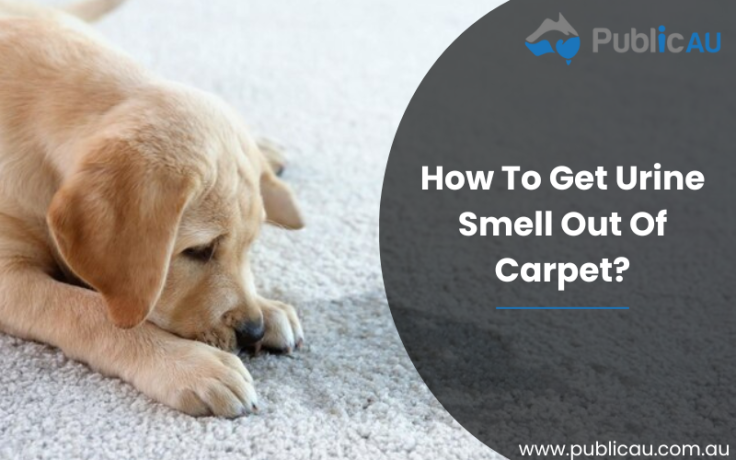
Let us understand detail guide of different types of carpet fibre and Pile cuts. When it comes to choosing the perfect carpet for your home or office, there are many thing to consider. Carpets not only impact the aesthetics of a space but also influence comfort and durability.
To help you make an informed decision, let’s delve into the diverse world of carpets, exploring different types of carpet fibre and Pile cuts and styles.
7 Common Carpet Fibres & Pile Options To Consider
⇒ Nylon:

Nylon carpet fabric is a popular and widely used choice in the world of carpeting, prised for its remarkable durability, stain resistance, and versatility. Nylon, a synthetic polymer, is crafted into carpet fibres that offer a range of benefits for both residential and commercial spaces.
Key Characteristics:
- Durability
- Stain Resistance
- Resilience
- Easy Maintenance
- Variety
Pros:
Durability: Nylon is incredibly durable, making it an excellent choice for high-traffic areas.
Stain Resistance: It is highly resistant to stains and is relatively easy to clean.
Easy Maintenance: Nylon carpets are easy to maintain and can withstand regular wear and tear.
Cons:
Cost: High-quality nylon carpets can be relatively expensive.
Static Buildup: In dry climates, nylon can build up static electricity, potentially causing discomfort.
⇒ Polypropylene (Olefin)
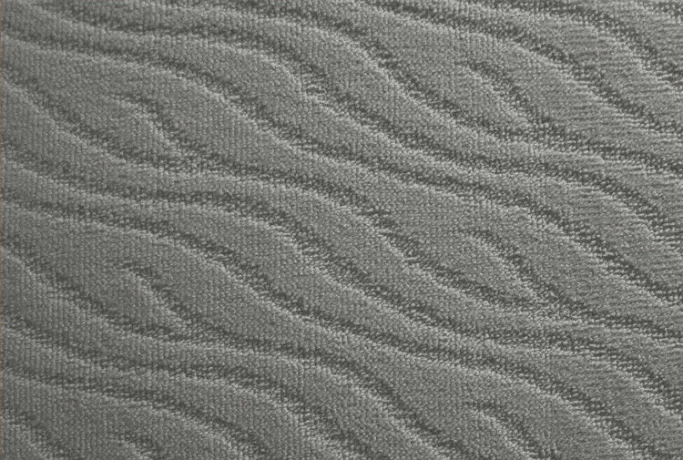
Polypropylene, often referred to as Olefin in the carpet industry, is a synthetic carpet fibre known for its affordability and practicality. It’s widely used in both residential and commercial settings due to its unique characteristics and benefits. Let’s explore Polypropylene (Olefin) carpet fibre in more detail, including its key features, advantages, and potential drawbacks.
Key Characteristics:
- Affordability
- Moisture Resistance
- Stain Resistance
- Colorfastness
Pros:
Affordability: Polypropylene carpet is one of the most budget-friendly options available, making it accessible to a wide range of consumers.
Moisture Resistance: Polypropylene is naturally moisture-resistant and does not absorb water. This makes it an excellent choice for areas prone to spills, high humidity, or dampness, such as basements and kitchens.
Stain Resistance: The fibres are inherently resistant to many types of stains, simplifying the cleaning process and reducing the risk of permanent staining. This is especially advantageous for households with children or pets.
Cons:
Durability: While Polypropylene is resistant to staining, it is generally not as durable as some other carpet fibres like nylon or wool. It may show signs of wear, matting, or flattening, especially in high-traffic areas.
Static Electricity: Similar to nylon, Polypropylene can build up static electricity, potentially causing discomfort or mild shocks, especially in dry climates.
Limited Styles: Polypropylene carpets may offer fewer style and texture options compared to other fibres. They may lack the plushness or luxurious feel of more expensive materials.
⇒ Polyester
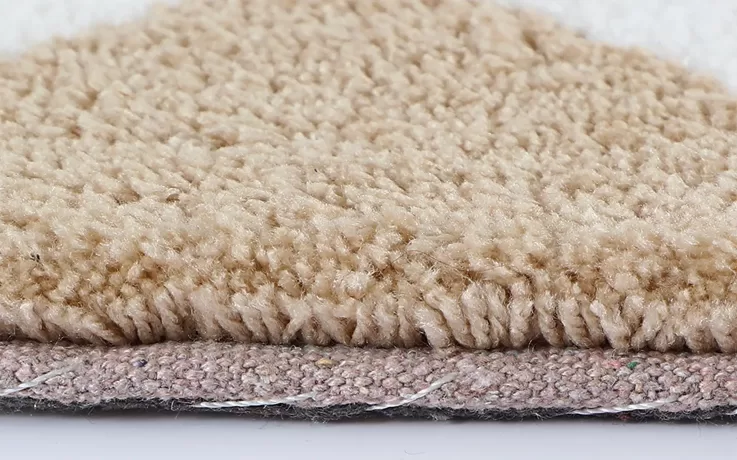
Polyester carpet fibre is a synthetic material known for its softness, vibrant colour options, and affordability. It is a popular choice in the carpet industry, offering various advantages and characteristics that make it suitable for a wide range of applications. Let’s explore Polyester carpet fibre in more detail, including its key features, advantages, and potential drawbacks.
Key Characteristics:
- Softness
- Colour Variety
- Affordability
Pros:
Soft Comfort: The softness of Polyester carpet makes it inviting and cozy, perfect for bedrooms, living rooms, and areas where comfort is a priority. It creates a warm and inviting ambiance.
Colour Retention: Polyester fibres are known for their excellent colour retention. They resist fading over time, even in rooms with a lot of natural sunlight, ensuring that the carpet’s vibrant hues endure.
Stain Resistance: Some Polyester carpets are treated with stain-resistant coatings, enhancing their practicality and making them easier to clean and maintain.
Cons:
Durability: While Polyester carpet offers softness and affordability, it may not be as durable as some other carpet fibres, such as nylon or wool. It can be prone to matting and wear, especially in high-traffic areas.
Susceptibility to Crushing: Over time, Polyester fibres may become flattened or crushed under heavy furniture or foot traffic, leading to a less plush appearance.
Static Buildup: Polyester can be more susceptible to static electricity, especially in dry climates, which can lead to discomfort and mild shocks.
⇒ Acrylic
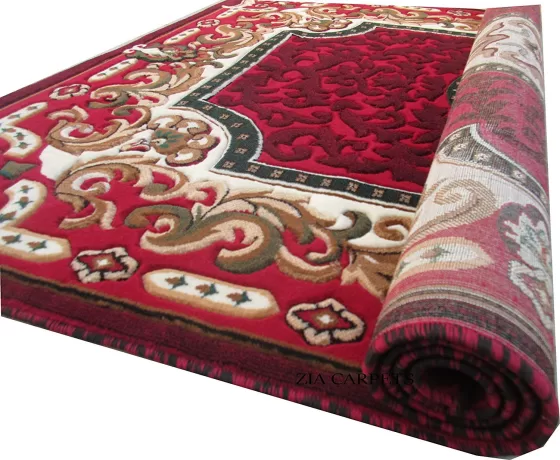
Acrylic carpet fabric is a synthetic material designed to mimic the luxurious look and feel of natural wool. It is known for its softness, resilience, and ability to capture the essence of natural fibres without the associated costs. Acrylic is a popular choice in the carpet industry, offering various characteristics and advantages. Let’s delve into Acrylic carpet fabric in more detail, including its key features, advantages, and potential drawbacks.
Key Characteristics:
- Softness
- Appearance
- Resilience
- Mould and Mildew Resistance
Pros:
Soft Luxury: Acrylic carpet offers the softness and luxury associated with natural wool but at a more affordable price point. It allows homeowners to enjoy the comfort and aesthetic appeal of wool without the higher cost.
Appearance: Acrylic carpets excel in capturing the visual beauty of natural fibres. They are available in a variety of colours and styles, providing design flexibility for various interior spaces.
Mould and Mildew Resistance: Acrylic’s resistance to mould and mildew growth makes it an excellent choice for areas with moisture concerns, such as basements or bathrooms.
Cons:
Durability: While acrylic is resilient, it may not be as durable as some other carpet fibres, such as nylon or wool. It can still show signs of wear over time, particularly in high-traffic areas.
Stain Vulnerability: Acrylic carpets are generally not as naturally resistant to stains as some other fibres. Spills and accidents may require immediate attention to prevent permanent staining.
Static Buildup: Acrylic can generate static electricity, potentially causing discomfort or mild shocks, especially in dry climates.
Price Point: While more affordable than natural wool, acrylic carpet may still be pricier than some other synthetic options, such as polyester or olefin.
⇒ Wool
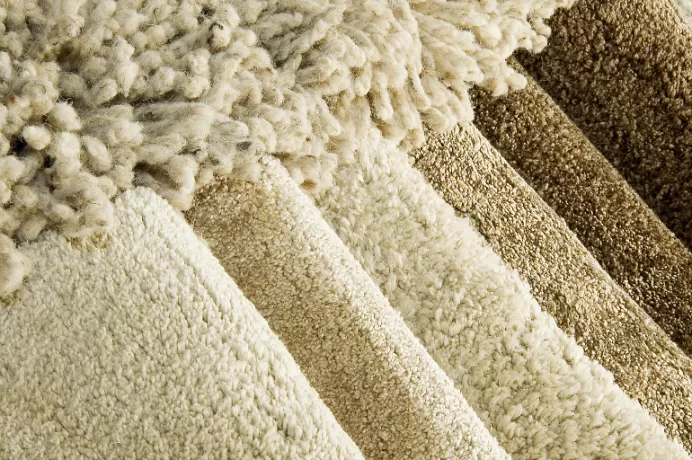
Wool carpet fabric is a luxurious and highly sought-after flooring material known for its timeless elegance, natural beauty, and exceptional quality. It is made from the fleece of sheep, particularly those of specific breeds renowned for their fine and soft wool. Wool carpets have been a staple in interior design for centuries and offer a range of unique characteristics and advantages. Let’s explore Wool carpet fabric in more detail, including its key features, advantages, and potential drawbacks.
Key Characteristics:
- Natural Fibre
- Softness and Comfort
- Durability
- Insulation
Pros:
Luxurious Feel: Wool carpets exude a luxurious and upscale ambiance. They are highly prized for their softness and comfort, making them ideal for bedrooms, living rooms, and other areas where a touch of luxury is desired.
Natural Beauty: Wool’s natural fibres create unique patterns and textures that add to the aesthetic appeal of a room. Its appearance is often described as warm, inviting, and visually pleasing.
Moisture Control: Wool has the ability to absorb and release moisture, helping to maintain balanced indoor humidity levels. This can contribute to a healthier living environment.
Cons:
Cost: Wool carpet is generally more expensive than carpets made from synthetic fibres. The high-quality and natural origin of wool contribute to its premium price.
Maintenance: Wool carpets require more maintenance and care compared to synthetic options. They can be susceptible to staining and may need professional cleaning to maintain their appearance.
Allergen Retention: Wool can trap allergens such as dust mites and pet dander. While it can contribute to better indoor air quality by absorbing pollutants, it may not be ideal for individuals with severe allergies.
7 Different Types Of Carpet Pile Cut
⇒ Loop Pile:
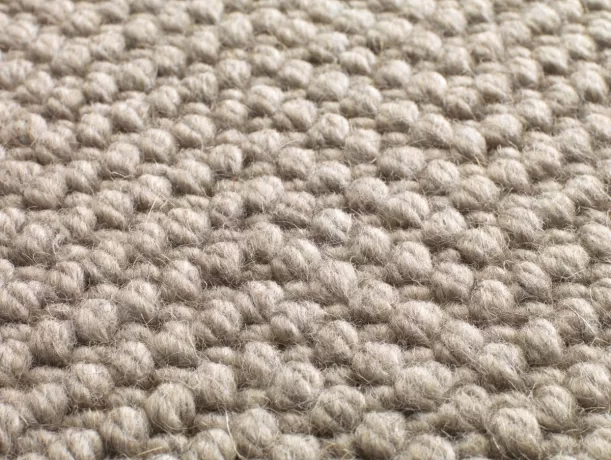
Loop pile carpet is a popular carpet style characterised by loops of yarn that create a distinct textured surface. It is known for its durability, resistance to wear and tear, and its ability to offer unique patterns and textures. Loop pile carpet comes in various variations, making it a versatile choice for both residential and commercial settings. Let’s delve into Loop Pile carpet in more detail, including its key features, advantages, and potential drawbacks.
Key Characteristics:
- Looped Surface
- Durability
- Texture and Patterns
Pros:
Durability: Loop pile carpets are exceptionally durable due to their looped structure. The loops help distribute the weight of foot traffic more evenly, reducing the likelihood of matting or crushing.
Texture Variety: They offer unique textures and patterns, adding visual interest to a room. Loop pile carpets can be tailored to suit different design aesthetics, from casual to formal.
Footprints and Vacuum Marks: Loop pile carpets are excellent at hiding footprints and vacuum marks due to their textured surface. This feature helps maintain a cleaner and more attractive appearance.
Cons:
Comfort: Some people may find loop pile carpets less comfortable underfoot compared to cut pile options, which tend to be softer and more cushioned.
Snagging: The loops in loop pile carpets can snag and unravel if not properly maintained. This is especially true in homes with pets or active children.
⇒ Cut Pile
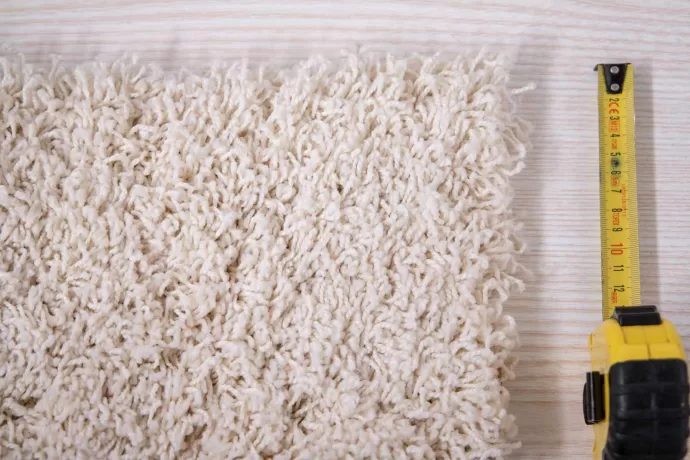
Cut pile carpet is one of the most popular and versatile carpet styles, known for its softness, plush texture, and comfort underfoot. It’s characterised by cut fibres that stand upright, creating a dense and luxurious surface. Cut pile carpet comes in various variations, making it suitable for a wide range of applications in residential and commercial settings. Let’s explore Cut Pile carpet in more detail, including its key features, advantages, and potential drawbacks.
Key Characteristics:
- Cut Fibres
- Softness and Comfort
- Versatility
Pros:
Plush Comfort: Cut pile carpets offer a plush, inviting feel underfoot, making them perfect for areas where comfort is a priority. The soft texture adds warmth and cosiness to a room.
Versatility: They come in various styles and textures, allowing homeowners to choose a carpet that suits their design preferences. From formal to casual, cut pile carpets can complement different interior aesthetics.
Durability: Higher quality cut pile carpets are durable and can withstand moderate foot traffic. They maintain their appearance and texture well over time.
Cons:
Footprints and Vacuum Marks: Cut pile carpets are prone to showing footprints and vacuum marks due to their soft texture. This can require more frequent maintenance to keep the surface looking pristine.
Not Ideal for High Traffic: While they are durable, cut pile carpets may wear down faster than some other carpet types in high-traffic areas. It’s important to choose a high-quality carpet for such spaces
⇒ Saxony Cut
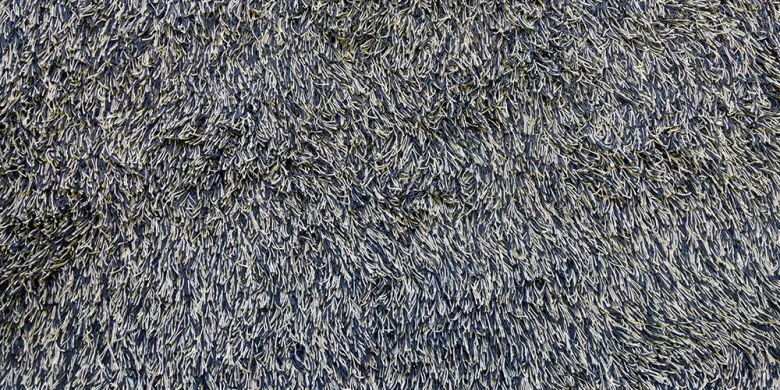
Saxony cut pile carpet is a specific variation of cut pile carpet known for its luxurious, soft, and elegant appearance. It is characterised by dense, closely packed, and evenly cut fibres that create a velvety and smooth surface. Saxony cut pile carpet is a popular choice for bedrooms, formal living areas, and other spaces where a plush and sophisticated look is desired. Let’s explore Saxony cut pile carpet in more detail, including its key features, advantages, and potential drawbacks.
Key Characteristics:
- Even, Upright Fibres
- Softness
- Formal Appearance
Pros:
Luxurious Feel: Saxony cut pile carpet provides a luxurious and upscale ambiance to a space. Its softness and comfort contribute to a warm and inviting atmosphere.
Elegant Appearance: The formal and refined look of Saxony carpets makes them well-suited for formal living rooms, dining rooms, and master bedrooms. They can enhance the overall aesthetics of these spaces.
Versatile Colour Options: Saxony carpets come in a wide range of colours and styles, allowing homeowners to find the perfect fit for their interior design preferences.
Cons:
Maintenance: Saxony cut pile carpet can be more challenging to maintain compared to other carpet styles, as it is prone to showing footprints, vacuum marks, and shading (light and dark patches). Regular vacuuming and grooming are essential to maintain its appearance.
Durability: While Saxony carpets are soft and elegant, they may not be as durable as some other carpet types, especially in high-traffic areas. They are best suited for spaces with moderate foot traffic.
Cost: Higher quality Saxony cut pile carpets can be relatively expensive due to their luxurious appearance and softness. Budget considerations may limit their use in some projects.
⇒ Plush Pile
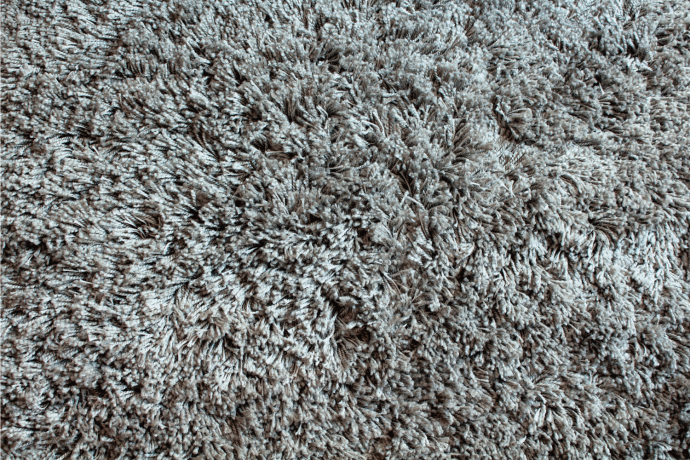
Plush pile carpet, often simply referred to as “plush carpet,” is a type of cut pile carpet known for its luxurious, soft, and uniform appearance. It features densely packed, evenly cut fibres that create a velvety, smooth surface with a consistent and elegant texture. Plush pile carpet is highly regarded for its comfort and sophisticated look, making it a popular choice for various residential and formal settings. Let’s explore Plush Pile carpet in more detail, including its key characteristics, advantages, and potential drawbacks.
Key Characteristics:
- Even, Dense Fibres
- Softness and Comfort
- Uniform Appearance
Pros:
Luxurious Feel: Plush pile carpet provides a luxurious and upscale ambiance. Its softness and comfort contribute to a warm and inviting atmosphere, making it ideal for bedrooms, formal living rooms, and other areas where comfort and sophistication are desired.
Formal Elegance: The uniform and plush texture of this carpet style lend it a formal and elegant appearance. It can enhance the aesthetics of formal living areas, dining rooms, and master bedrooms.
Versatile Colour Options: Plush pile carpets are available in a wide range of colours and styles, allowing homeowners to choose a carpet that complements their interior design preferences.
Cons:
Maintenance: Plush pile carpet can be more challenging to maintain compared to other carpet styles, as it is prone to showing footprints, vacuum marks, and shading (light and dark patches). Regular vacuuming and grooming are necessary to preserve its appearance.
Durability: While plush carpets offer exceptional softness and comfort, they may not be as durable as some other carpet types, especially in high-traffic areas. They are best suited for spaces with moderate foot traffic.
Cost: Higher quality plush pile carpets can be relatively expensive due to their luxurious appearance and softness. Budget considerations may limit their use in some projects.
⇒ Texture Cut
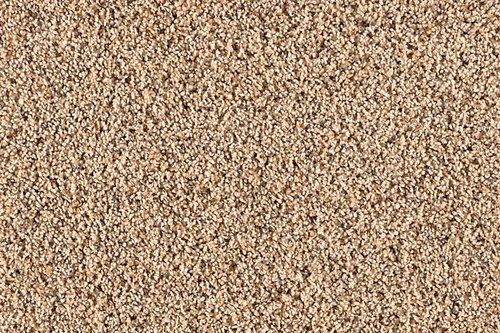
Textured cut pile carpet is a versatile and popular carpet style known for its casual elegance and ability to conceal footprints and vacuum marks. It combines the softness of a cut pile with a textured surface that adds visual interest to a room. Textured cut pile is suitable for various residential and commercial settings and offers a balance between comfort and durability. Let’s explore Textured Cut Pile carpet in more detail, including its key characteristics, advantages, and potential drawbacks.
Key Characteristics:
- Mixed Fibre Lengths
- Softness and Comfort
- Concealing Texture
Pros:
Casual Elegance: Textured cut pile carpet combines the elegance of cut pile with a more relaxed and casual appearance. It’s versatile and can suit a variety of interior design styles, from traditional to contemporary.
Camouflages Imperfections: The textured surface effectively conceals footprints, vacuum tracks, and shading, making it an excellent choice for areas with high foot traffic.
Durability: Textured cut pile carpets tend to be more durable than some other carpet styles. They can withstand moderate foot traffic and maintain their appearance over time.
Cons:
Maintenance: While textured cut pile carpets hide footprints and vacuum marks, they still require regular maintenance to keep them looking their best. Regular vacuuming and occasional deep cleaning are necessary.
Not as Formal: While it offers elegance, the textured appearance of this carpet style may not be as formal as Saxony or plush pile options. It’s important to consider the desired level of formality when choosing a carpet.
⇒ Frieze Cut Pile
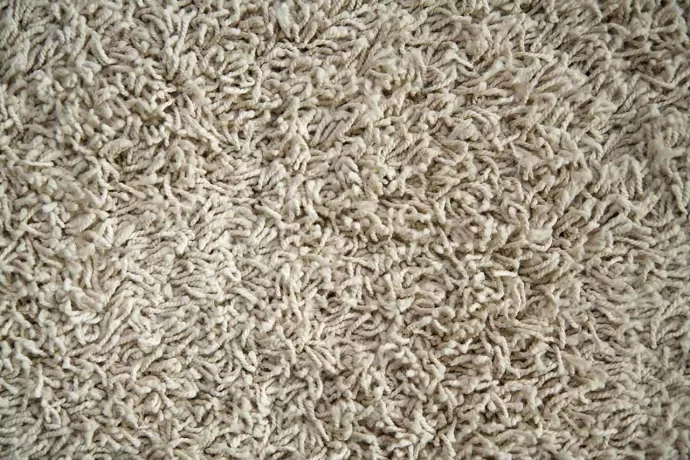
Frieze cut pile carpet, also known as “twist” or “shag,” is a modern and stylish carpet style known for its unique appearance and durability. It features tightly twisted fibres that create a textured and informal surface. Frieze cut pile is a popular choice for contemporary and casual interior settings, offering a range of advantages and characteristics. Let’s explore Frieze Cut Pile carpet in more detail, including its key features, advantages, and potential drawbacks.
Key Characteristics:
- Tightly Twisted Fibres
- Casual Appearance
- Durability
Pros:
Modern Aesthetics: Frieze cut pile carpets are favoured for their contemporary and trendy appearance. They add a touch of modern style to interior spaces.
Texture and Comfort: The textured surface of frieze carpet provides a unique tactile experience. It adds comfort and warmth to a room, making it suitable for bedrooms and living areas.
Conceals Imperfections: The texture of frieze carpet helps conceal footprints, vacuum marks, and shading. This makes it easier to maintain a clean and attractive appearance.
Cons:
Maintenance: While it hides imperfections well, frieze cut pile carpets require regular maintenance to keep them looking their best. Vacuuming and occasional deep cleaning are necessary.
Not as Formal: Frieze carpet may not be the best choice for formal spaces due to its relaxed appearance. It’s better suited for contemporary or casual settings.
Not Ideal for Pets: The long, twisted fibres of frieze carpet can sometimes catch pet claws, leading to snags and damage.
⇒ Sculpted Pile:
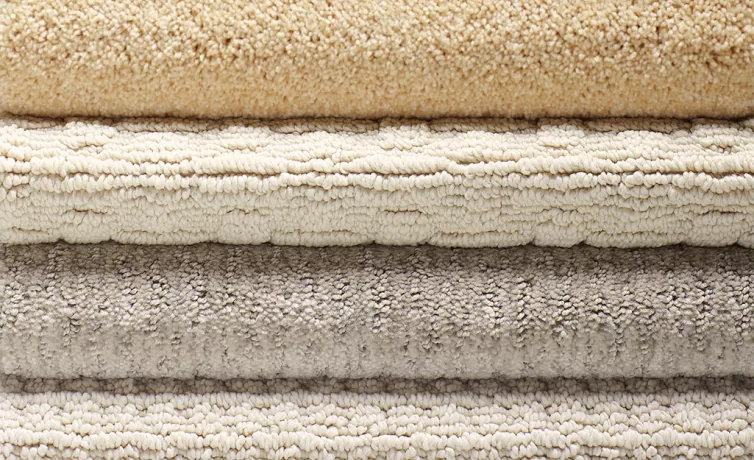
Sculpted pile carpet, also known as “sculptured” or “carved” carpet, is a creative and visually engaging carpet style that goes beyond the traditional flat surfaces of most carpets. It features a combination of cut and looped fibres that create intricate patterns, designs, and varied textures on the carpet’s surface. Sculpted pile carpet is celebrated for its ability to add depth, dimension, and artistic flair to interior spaces. Let’s explore Sculpted Pile carpet in more detail, including its key characteristics, advantages, and potential drawbacks.
Key Characteristics:
- Variety of Surface Heights
- Intricate Patterns and Designs
- Artistic Appeal.
Pros:
Visual Interest: Sculpted pile carpet adds visual interest and complexity to interior spaces. The intricate patterns and designs create a sense of depth and dimension that can elevate the overall decor.
Artistic Expression: It offers an opportunity for artistic expression in interior design. Homeowners can choose from a variety of sculpted patterns and designs to match their personal style and decor preferences.
Camouflages Imperfections: Like other textured carpets, sculpted pile carpets are effective at concealing footprints, vacuum marks, and shading, helping maintain a cleaner and more attractive appearance.
Cons:
Maintenance: The textured surface of sculpted pile carpet can make vacuuming more challenging, as dirt and debris can become trapped in the various heights of fibres. Regular cleaning and maintenance are required to keep it looking its best.
Not Ideal for High-Traffic Areas: While sculpted pile carpets can add a unique touch to a room, they may not be the best choice for high-traffic areas due to the complexity of the surface, which can wear down faster.
Potential for Snagging: The looped fibres in sculpted pile carpets may be more susceptible to snagging, especially in homes with pets or active children.



